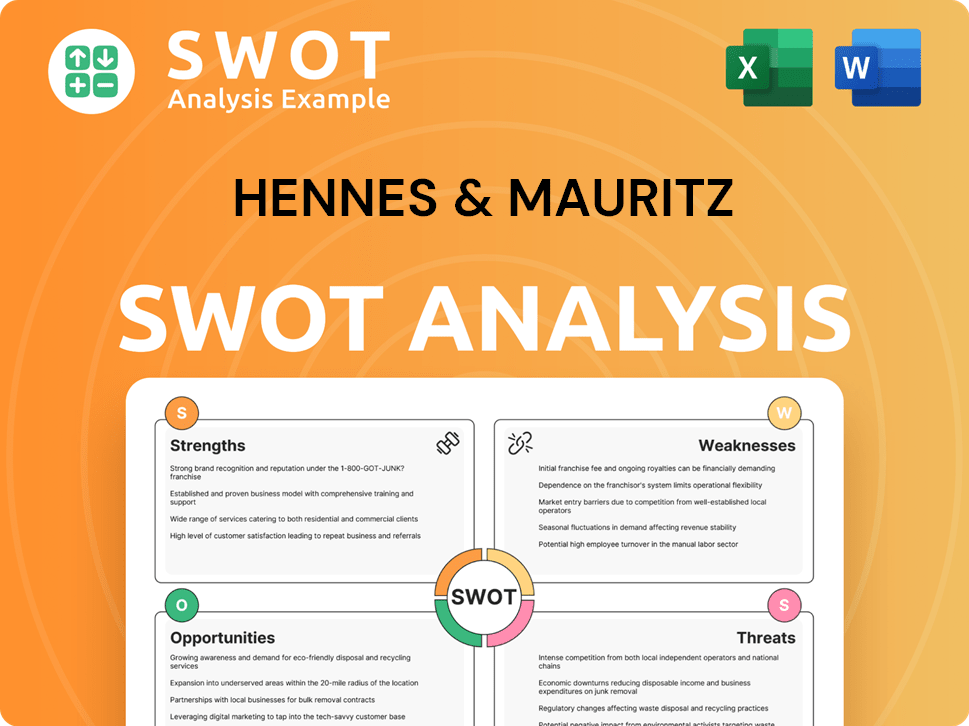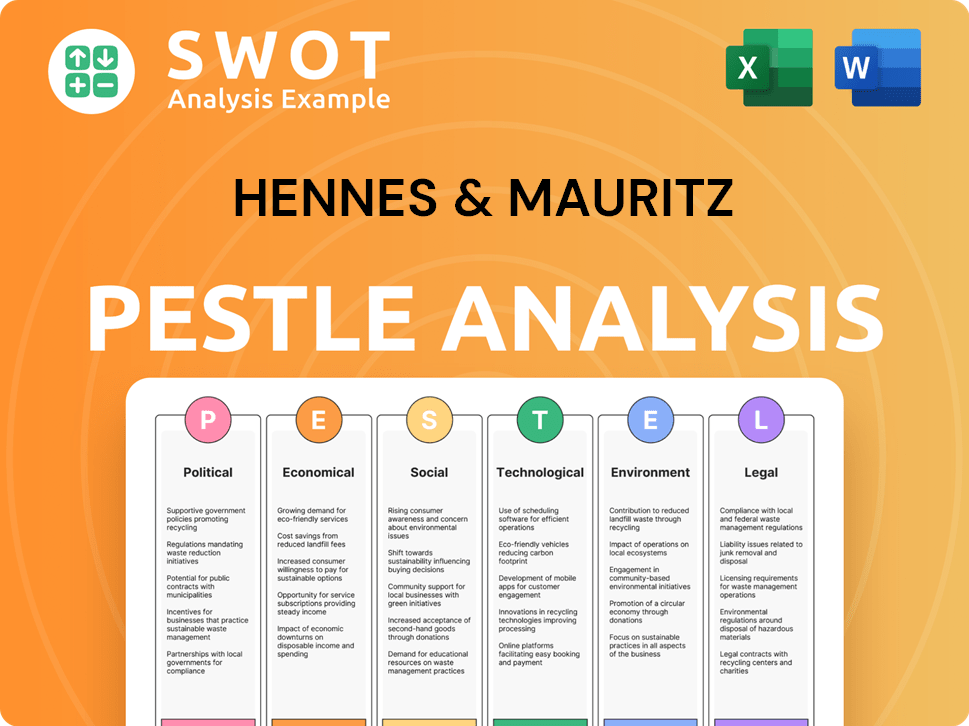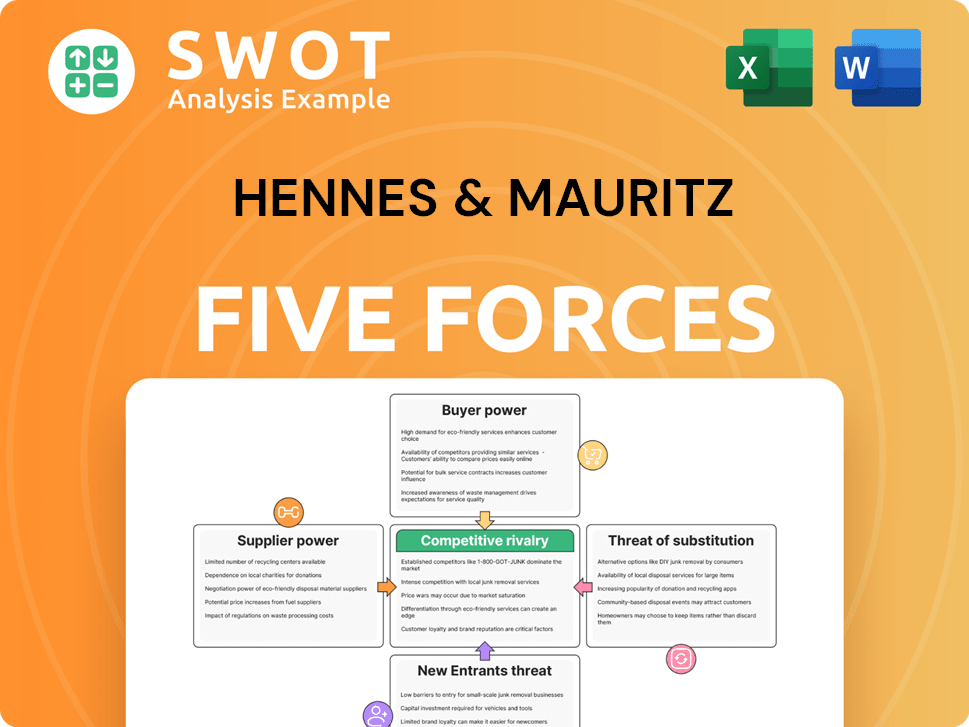Hennes & Mauritz Bundle
How Does Hennes & Mauritz Thrive in the Fashion World?
Hennes & Mauritz (H&M), a global fashion retail leader, has captivated consumers worldwide with its promise of "fashion and quality at the best price in a sustainable way." From its humble beginnings in 1947, H&M has blossomed into a retail giant, boasting a diverse brand portfolio including COS, Weekday, and Monki. With thousands of stores globally and a robust online presence, understanding the Hennes & Mauritz SWOT Analysis is crucial to understanding its operations.

This exploration into the H&M business model will dissect its core operations, examining its H&M supply chain, retail strategy, and commitment to H&M sustainability. We'll uncover how this fashion powerhouse manages its inventory, designs clothes, and navigates the fast-paced world of fashion. Furthermore, we will analyze H&M's financial performance, expansion strategies, and its approach to ethical sourcing, providing a comprehensive understanding of this retail giant.
What Are the Key Operations Driving Hennes & Mauritz’s Success?
The core of the Hennes & Mauritz (H&M) business model revolves around delivering trendy, affordable fashion and home goods. This value proposition targets a broad customer base that values both style and price. H&M offers clothing, accessories, and home goods for women, men, and children, ensuring a wide range of options for its customers.
H&M serves diverse customer segments globally through an omni-channel approach. This strategy integrates physical stores and online platforms to offer a seamless shopping experience. As of February 28, 2025, H&M operated over 4,200 stores worldwide, showcasing its extensive global presence and accessibility.
Operational processes are central to H&M's value delivery, emphasizing efficient supply chain management, in-house design, and a fast-fashion model. This allows for quick responsiveness to emerging trends. The company focuses on accelerating product creation processes, increasing the precision in aligning supply with demand, and improving product availability by closely integrating online and in-store channels.
The fast-fashion model is a cornerstone of H&M operations, enabling quick responses to the latest trends. This approach involves rapid design, production, and distribution cycles to keep up with consumer demand. This agility allows H&M to offer new styles frequently, attracting customers seeking the latest fashion.
H&M retail strategy includes an omni-channel approach, integrating physical stores and online platforms. This strategy ensures a seamless shopping experience for customers. By offering multiple points of access, H&M enhances customer convenience and accessibility.
H&M leverages in-house design capabilities to create unique and trendy products. This allows the company to control the design process, ensuring that new styles align with current fashion trends. This control over design helps H&M stay ahead of competitors.
H&M benefits from strong brand recognition and a global presence, with stores in numerous countries. This widespread reach allows H&M to cater to diverse customer segments worldwide. The strong brand recognition helps build customer loyalty and trust.
What distinguishes H&M is its commitment to sustainability alongside its fast-fashion model. In 2024, 89% of the materials used in its products were either recycled or sustainably sourced, with a goal of 100% by 2030. H&M aims for 30% recycled materials by 2025 and 50% by 2030, having already reached 29.5% recycled materials in 2024. This focus on H&M sustainability translates into customer benefits by offering more responsibly made products and differentiating H&M from competitors. For further insights, explore the Growth Strategy of Hennes & Mauritz.
H&M's competitive strengths include in-house design, strong brand recognition, global reach, and the ability to offer affordable products and great experiences in a sustainable way.
- In-house design teams ensure that new styles align with current fashion trends.
- Strong brand recognition builds customer loyalty and trust.
- Global reach allows H&M to cater to diverse customer segments worldwide.
- Commitment to sustainability offers responsibly made products.
Hennes & Mauritz SWOT Analysis
- Complete SWOT Breakdown
- Fully Customizable
- Editable in Excel & Word
- Professional Formatting
- Investor-Ready Format

How Does Hennes & Mauritz Make Money?
The core of the Hennes & Mauritz (H&M) business model revolves around generating revenue through the sale of fashion apparel, accessories, and home goods. The company's ability to quickly adapt to changing trends and offer products at competitive prices is central to its monetization strategy. H&M's extensive global presence, combining physical stores and a robust online platform, allows it to reach a broad customer base and drive sales.
For the fiscal year 2024, H&M's net sales reached SEK 234,478 million (approximately €21.39 billion), reflecting a 1% increase in local currencies. Online sales played a significant role, contributing around 30% of the total sales. The company's financial performance demonstrates its ability to maintain revenue growth despite market fluctuations.
In the first quarter of fiscal 2025, H&M's net sales increased by 3% to SEK 55,333 million (approximately $5.26 billion), with a 2% increase in local currencies. This growth was achieved despite a 3% reduction in the number of stores. The gross profit for Q1 FY25 was SEK 27,169 million, resulting in a gross margin of 49.1%.
H&M's monetization strategies are multifaceted, leveraging its fast-fashion model and global reach. The company focuses on rapid design-to-market cycles and competitive pricing to attract and retain customers. H&M's approach includes a blend of physical and digital channels to maximize sales.
- Fast-Fashion Model: Quickly bringing new designs to market at affordable prices is a core strategy.
- Global Presence: Operating stores in over 75 markets and e-commerce in 60 markets allows H&M to tap into diverse customer bases.
- Cross-Selling: Utilizing a diverse product range, including clothing, cosmetics, footwear, and home items, to increase sales per customer.
- Digital Experience: Continuously optimizing its online platform to enhance the customer shopping experience.
- Sustainability Initiatives: Investing in circular fashion, such as pre-owned offerings available in 26 markets, to meet growing consumer demand for sustainable options. This is part of H&M's commitment to its target market.
Hennes & Mauritz PESTLE Analysis
- Covers All 6 PESTLE Categories
- No Research Needed – Save Hours of Work
- Built by Experts, Trusted by Consultants
- Instant Download, Ready to Use
- 100% Editable, Fully Customizable

Which Strategic Decisions Have Shaped Hennes & Mauritz’s Business Model?
Navigating the fast-paced fashion industry, Hennes & Mauritz (H&M) has consistently adapted its strategies to maintain its market position. This involves a dynamic approach to its store portfolio, strategic brand integrations, and a strong emphasis on sustainability. The company's ability to respond to evolving consumer preferences and economic conditions is crucial to its continued success.
H&M's operational adjustments, including store closures and openings, reflect its commitment to optimizing its physical presence. Simultaneously, the company has focused on enhancing its product offerings and supply chain efficiency. These efforts are designed to improve profitability and adapt to changing consumer demands.
The company's strategic moves are aimed at streamlining operations and enhancing its competitive edge. H&M's focus on sustainability and circular business models further solidifies its position in the market. These initiatives are integral to its long-term strategy and resonate with the values of today's consumers.
H&M has strategically managed its store portfolio, opening new locations while closing others to optimize its footprint. In fiscal year 2024, H&M opened 88 new stores and closed 204, resulting in a global presence of over 4,200 stores. For 2025, the company plans to open around 80 new stores and close approximately 190, further streamlining its physical presence.
A key strategic move for 2025 involves integrating the Monki brand into Weekday, both in stores and online, to streamline operations. H&M discontinued Afound during 2024 to optimize its operations. The company has responded to macroeconomic challenges and increased markdowns by focusing on strengthening its product offerings, particularly in womenswear.
H&M's competitive advantages include its strong brand identity and global presence in over 75 markets. The company benefits from an efficient supply chain, allowing quick responses to fashion trends. A significant competitive edge is H&M's strong commitment to sustainability. In 2024, 89% of its materials were recycled or sustainably sourced, with a goal to reach 100% by 2030.
H&M faced challenges such as macroeconomic conditions and increased markdowns, which impacted its gross margin in Q1 2025, leading to a decrease in operating profit to SEK 1.2 billion. Despite these challenges, H&M has focused on strengthening its product offerings and improving its supply chain. This includes deepened supplier partnerships, shortened product development cycles, improved demand forecasting, and expanded nearshoring capacity. For a deeper understanding, explore the Brief History of Hennes & Mauritz.
Hennes & Mauritz Business Model Canvas
- Complete 9-Block Business Model Canvas
- Effortlessly Communicate Your Business Strategy
- Investor-Ready BMC Format
- 100% Editable and Customizable
- Clear and Structured Layout

How Is Hennes & Mauritz Positioning Itself for Continued Success?
As of November 2024, Hennes & Mauritz (H&M) holds a strong position in the global fashion market, ranking as the second-largest international clothing retailer. The company operates in over 75 markets with around 4,200 stores, and has a significant online presence, reaching 60 markets. This widespread reach, combined with strong brand recognition, contributes to H&M's solid market position and customer loyalty.
However, H&M faces several risks. These include economic uncertainty, geopolitical events, and shifting consumer preferences. The company also deals with intense competition from other fast-fashion retailers, luxury brands, and department stores. Supply chain disruptions and increasing scrutiny regarding sustainability and ethical practices pose additional challenges. These factors can affect H&M's operations and revenue, requiring continuous adaptation and investment.
H&M is the second-largest international clothing retailer after Inditex (Zara), with a global presence in 75 markets. The company's extensive store network and online platform contribute to its strong market position. H&M's brand recognition fosters trust and a loyal customer base, which supports its market share.
H&M faces risks from global economic uncertainty and changing consumer preferences. Intense competition from other retailers and supply chain disruptions also pose challenges. The fast-fashion industry's sustainability concerns require continuous investment and adaptation. These factors could impact H&M's financial performance.
H&M is focused on strengthening its core business and enhancing its customer offering. Strategic initiatives include improving product creation processes and integrating online and physical channels. Sustainability is a key priority, with goals to reduce emissions and use sustainable materials. CEO Daniel Ervér is optimistic about long-term growth.
H&M is focused on speeding up product creation and improving product availability. The company aims to enhance the digital experience and strengthen its brand presence. Investments in stores and the supply chain are ongoing. Sustainability efforts include reducing greenhouse gas emissions and using sustainably sourced materials.
Looking ahead to 2025, H&M is prioritizing several strategic initiatives to drive growth and profitability. These include streamlining product creation processes, improving supply chain efficiency, and enhancing the integration of online and physical retail channels. Investments in both store infrastructure and the supply chain remain a focus, alongside efforts to improve the digital customer experience and reinforce the brand's presence in key fashion markets. H&M is also committed to sustainability, aiming to reduce greenhouse gas emissions by 56% by 2030 and to use 100% sustainably sourced or recycled materials by the same year. The company's approach, as outlined in the Growth Strategy of Hennes & Mauritz, emphasizes a strong focus on its core business, an integrated customer experience, and a commitment to sustainability to achieve long-term, profitable growth, as highlighted by CEO Daniel Ervér.
H&M is dedicated to reducing its environmental impact through ambitious sustainability targets. The company plans to cut greenhouse gas emissions significantly by 2030. H&M is also committed to sourcing materials sustainably and phasing out coal use.
- Reduce greenhouse gas emissions by 56% by 2030.
- Phase out on-site coal use by 2026 for garment suppliers.
- Target 100% sustainably sourced or recycled materials by 2030.
- Focus on sustainable practices to enhance H&M's brand reputation.
Hennes & Mauritz Porter's Five Forces Analysis
- Covers All 5 Competitive Forces in Detail
- Structured for Consultants, Students, and Founders
- 100% Editable in Microsoft Word & Excel
- Instant Digital Download – Use Immediately
- Compatible with Mac & PC – Fully Unlocked

Related Blogs
- What are Mission Vision & Core Values of Hennes & Mauritz Company?
- What is Competitive Landscape of Hennes & Mauritz Company?
- What is Growth Strategy and Future Prospects of Hennes & Mauritz Company?
- What is Sales and Marketing Strategy of Hennes & Mauritz Company?
- What is Brief History of Hennes & Mauritz Company?
- Who Owns Hennes & Mauritz Company?
- What is Customer Demographics and Target Market of Hennes & Mauritz Company?
Disclaimer
All information, articles, and product details provided on this website are for general informational and educational purposes only. We do not claim any ownership over, nor do we intend to infringe upon, any trademarks, copyrights, logos, brand names, or other intellectual property mentioned or depicted on this site. Such intellectual property remains the property of its respective owners, and any references here are made solely for identification or informational purposes, without implying any affiliation, endorsement, or partnership.
We make no representations or warranties, express or implied, regarding the accuracy, completeness, or suitability of any content or products presented. Nothing on this website should be construed as legal, tax, investment, financial, medical, or other professional advice. In addition, no part of this site—including articles or product references—constitutes a solicitation, recommendation, endorsement, advertisement, or offer to buy or sell any securities, franchises, or other financial instruments, particularly in jurisdictions where such activity would be unlawful.
All content is of a general nature and may not address the specific circumstances of any individual or entity. It is not a substitute for professional advice or services. Any actions you take based on the information provided here are strictly at your own risk. You accept full responsibility for any decisions or outcomes arising from your use of this website and agree to release us from any liability in connection with your use of, or reliance upon, the content or products found herein.